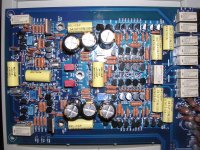The octagonal would fit better to the “nut” description.
Don't you mean hexagonal?
se
No, but it could have been, if I had personally done the CHANGES that we necessarily have to make with prototypes. Yesterday, on a similar prototype, it took 1 hour or more to change 4 identical value resistors with 4 others of a different value. It is time consuming and cramped to modify a board stuffed so tightly. Never again! I will hold out for MORE SURFACE AREA. I swear at it, every time we have to change something.
Last edited:
Don't you mean hexagonal?
se
Thanks Steve.
I don’t qualify even for a “nut”.
George
prototypes.
Looks like a twin V8, with pushrods.
Thanks Steve.
I don’t qualify even for a “nut”.
Well, as the old Hershey's jingle goes (for their Almond Joy and Mounds candy bars), sometimes you feel like a nut, sometimes you don't.
se
Yep, see the Dvorak keyboard. Much better, never widely accepted. Too bad.I If I'm designing a keyboard to actually sell, it's not likely that my remapped version will succeed, even if I can argue that QWERTY is "wrong." The market has a lot of inertia!
This design is about 4 times more complex than a single ended input design, and not any quieter.
If taken as an isolated block. If you can be sure that there will never be common-mode noise induced at nanovolt levels between the cartridge and the preamp, including pickup of fields by the cartridge, great. Someone who is more concerned with overall system performance might prefer that common mode pickup be rejected.
Yep, see the Dvorak keyboard. Much better, never widely accepted. Too bad.
I tried using one. Massive failure- muscle memory is a tough thing to change. Maybe that's why I rarely use open tunings on my guitar...
If taken as an isolated block. If you can be sure that there will never be common-mode noise induced at nanovolt levels between the cartridge and the preamp, including pickup of fields by the cartridge, great. Someone who is more concerned with overall system performance might prefer that common mode pickup be rejected.
Getting decent real world common mode rejection is very difficult. Bill Whitlock has written a lot about the problem. If there is an unbalance in impedance to ground anywhere in the chain the CMRR goes out the window. There is nothing about a transducer that makes its output intrinsically balanced unless it has a center tap. And that will only be true at DC. MC cartridges make it easier, since they are so low Z, to reject voltage fields. But they can be very sensitive to magnetic fields. Optimizing all the pieces to work well together would really require different wiring and connectors from the shell out. The ground reference for the system would be in the headshell. An avid DIYer could make this work but not without a lot of effort. I think most dealers would throw it back at a manufacturer as too much trouble.
That's actually not too far from how I (and several others) have wired our turntables- the "ground" wire connects to the phono preamp chassis and the cartridge is connected via a screened, twisted pair. As I mentioned, the CMR is good enough that I can't seem to induce hum even using extreme measures.
There's a very nice writeup about this in "Valve Amplifiers."
I disagree about the center-tap bit. That can actually degrade CMR.
There's a very nice writeup about this in "Valve Amplifiers."
I disagree about the center-tap bit. That can actually degrade CMR.
Joachim has shown more than many circuits.
I saw his latest one (balanced to single ended) here
http://www.diyaudio.com/forums/analogue-source/226508-openamp1-mm-phono-preamp-open-project.html#post3301025
Frankly, not my cup of tea.
Getting decent real world common mode rejection is very difficult.
Not really, no.
Bill Whitlock has written a lot about the problem. If there is an unbalance in impedance to ground anywhere in the chain the CMRR goes out the window.
Yes, when you're talking about typical electronically balanced inputs. Transformers are a whole other matter. A good transformer can give you good common-mode rejection even when driven from a wholly unbalanced source due to their incredibly high common-mode input impedance.
It's precisely that characteristic of transformers that Bill was looking to emulate with his inGenius circuit that he licensed to THAT Corp.
se
- Status
- Not open for further replies.
- Home
- Member Areas
- The Lounge
- John Curl's Blowtorch preamplifier part II
